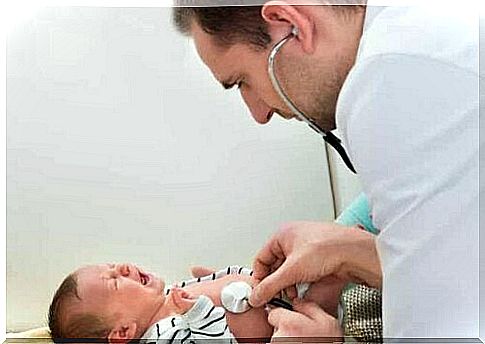Hypermobility In Infants: Pros And Cons

Hypermobility in infants is a common asymptomatic condition in children under 5 years of age that causes the joints to move outside the normal limits. It occurs when the collagen level in tendons and ligaments changes, making the fibers thinner and less stiff.
It occurs on average in 30% of the child population, and is more common in girls than in boys, in a ratio of 3 to 1. Although it decreases with age, in 2% of cases it is prolonged in time.
In this article, we will reveal some characteristics that make it possible to diagnose this condition. At the same time, we will look at the benefits as well as the disadvantages of hypermobility in infants, and most importantly, we will tell you when you should be concerned.
What causes hypermobility in infants?
Hypermobility in infants is genetic. Studies indicate that it originates in a mutation in the fibers that make up the tendons, muscles and skin.
These specialize in stretching and returning to their shape, or deforming and adopting a new one, known as plasticity.
This is where the proteins that form the tissues act: collagen and elastin. When there is more elastin than collagen, the muscles become more elastic, and therefore the joints become more fragile. Therefore, it is very easy for injuries to occur in the musculoskeletal system.
What are the benefits?
In physical activities such as gymnastics, ballet, dance or acrobatics, hypermobility can be positive because it provides a flexibility that borders on amazing. It is also beneficial for playing instruments, such as flute, violin or piano, which require special agility in the fingers.
In the specific case of those with hypermobility, distension and constant tension of repeated movements do not cause pain in the same way as it does in those athletes who are less flexible.

Disadvantages of hypermobility in infants
Hypermobility in infants can be interpreted as an advantage in the mentioned physical activities, although specialists recommend to be careful. Muscle weakness and motor clumsiness can be a problem, and even delays in psychomotor development can occur.
Joint dislocations, tendonitis, back pain, scoliosis, knee arthritis, and according to research, anxiety and depression tend to occur. These problems are usually not associated with hypermobility in the joints. Some symptoms deserve special attention.
Muscle hypotension
Muscle weakness causes delayed psychomotor development, such as turning, sitting, crawling and walking. These infants have very flexible joints, bend easily and the muscle tone does not resist movement.
These babies do not kick and the limbs are more stretched than normal. With the face down, they become desperate because they can not lean on their arms or lift their heads. When they finally get up, they try to spread their legs, their feet turn outwards and their knees go backwards.
Inhibition of muscle activity
As a result of pain, inhibition occurs, resulting in muscular hypotrophy. This in turn reduces exercise tolerance and therefore reduces the child’s participation in sports and play. Delays in psychomotor development and the acquisition of walking are also a possibility.
Scoliosis and other postural problems
Studies point to a statistical relationship between joint hypermobility and scoliosis, due to postural changes. This causes curvature in the posterior part of the spine, known as kyphosis, and increased curvature in the lower back.
Many have flat feet and knees that are close together and shifted backwards.
Advice and recommendations for parents
A child with hypermobility should learn about their condition to prevent constant repetition of joint movements that are outside the normal range. It will be difficult to control this natural hyperactivity, and the child will probably seek to attract an audience with their distortion skills.
Now that abnormal flexion of the joints is not necessarily a good thing, as mentioned by doctors, we will offer certain recommendations that will be useful:
- Since there is no specific treatment, parents should inform the child about the need to protect the joints from prolonged over-extension.
- Try to steer the child towards sports and exercises that work with the muscles and improve balance, stability and motor dexterity.
- If the child diagnosed with hypermobility is an infant, parents should seek to strengthen the child’s muscle tone. To do this, it would be best to consult a physiotherapist for special advice.
- Among the recommended exercises you need to do at home are those that lay the baby down, a position that, given the condition, they will not like at all. These help little ones to strengthen their backs, necks and hips.
- But since they find this annoying, you need to stimulate them with toys or sounds that make them lift their heads.
When should I seek medical treatment for hypermobility in infants?
Hypermobility in infants can be fun until the pain appears. This is not common, since only 5 to 10% of hypermobile or very flexible people suffer from discomfort. And if that happens, you need to go to the doctor because you are looking at hypermobility syndrome in joints.
The Beighton scale is the most widely used to know if a person is hypermobile. Among the maneuvers it involves are touching the forearm with the thumb, stretching the fingers to more than 90 degrees, or touching the floor with the palm of the hand without bending the knees. If the child gets 6 of the 9 points on the scale, there is a positive case of hypermobility in the joints.
This aggravated disorder causes pain in the joints and bones, even when you hold a pencil for a while. It is also accompanied by discomfort in the hips and knees and flat feet, bruxism, fatigue and weakness.
Benign hypermobility syndrome is different from Ehlers-Danlos syndrome, which is also congenital and also affects the connective tissue. EDS causes vascular and ocular problems and hypersensitivity of the skin. It is also accompanied by regular distortions, spinal deformities, muscle hypotension and joint outflows.

Hypermobility in infants requires constant training
The encouragement to parents is to pay attention to manifestations that can reveal major problems. The condition is not easy to diagnose because the symptoms are diffuse. However, pain gives the alarm signal.
When a child is diagnosed with benign hypermobility, they should follow the guidelines for treatment. This includes a balanced diet, exercise, participation in school activities and high quality sleep. Avoid overloading the joints (eg heavy schoolbag) and extreme sports or contact sports.
Having taken these considerations, it is important to emphasize that periods of inactivity increase the symptoms of hypermobility. In this regard, a progressive strength training program with a focus on specific muscles is recommended. Finally, cycling and swimming are among the first choices of healthy exercise for this.









